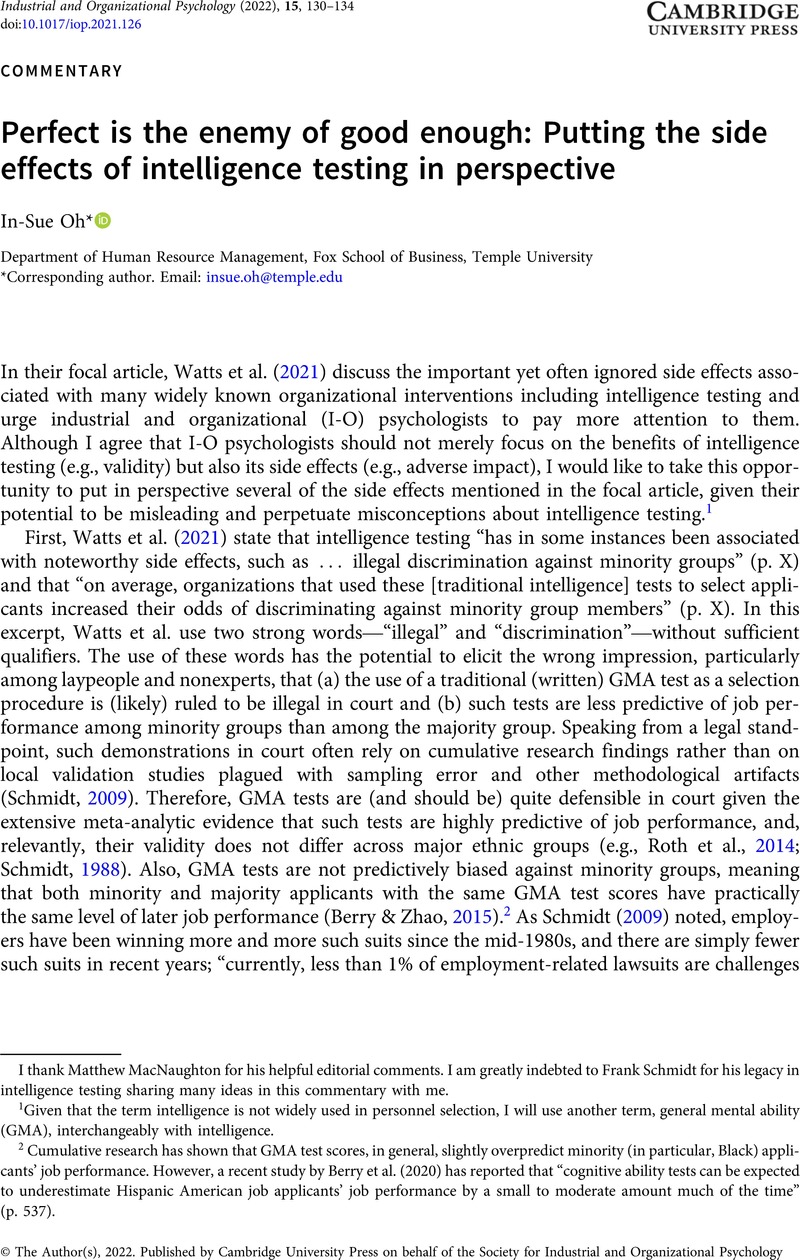No CrossRef data available.
Article contents
Perfect is the enemy of good enough: Putting the side effects of intelligence testing in perspective
Published online by Cambridge University Press: 29 March 2022
Abstract
An abstract is not available for this content so a preview has been provided. Please use the Get access link above for information on how to access this content.

- Type
- Commentaries
- Information
- Copyright
- © The Author(s), 2022. Published by Cambridge University Press on behalf of the Society for Industrial and Organizational Psychology
Footnotes
I thank Matthew MacNaughton for his helpful editorial comments. I am greatly indebted to Frank Schmidt for his legacy in intelligence testing sharing many ideas in this commentary with me.
References
Berry, C. M., & Zhao, P. (2015). Addressing criticisms of existing predictive bias research: cognitive ability test scores still overpredict African Americans’ job performance. Journal of Applied Psychology, 100(1), 162–179. https://doi.org/10.1037/a0037615
CrossRefGoogle ScholarPubMed
Berry, C. M., Zhao, P., Batarse, J. C., & Reddock, C. (2020). Revisiting predictive bias of cognitive ability tests against Hispanic American job applicants. Personnel Psychology, 73(3), 517–542. https://doi.org/10.1111/peps.12378
CrossRefGoogle Scholar
De Corte, W., Lievens, F., & Sackett, P. R. (2021). A comprehensive examination of the cross-validity of pareto-optimal versus fixed-weight selection systems in the biobjective selection context. Journal of Applied Psychology. Advance online publication. https://doi.org/10.1037/apl0000927
CrossRefGoogle Scholar
Hartigan, J. A., & Wigdor, A. K. (Eds.) (1989). Fairness in employment testing: Validity generalization, minority issues and the General Aptitude Test Battery. National Academy of Sciences Press.Google Scholar
Oh, I.-S. (2013). Adverse impact is unlikely to be eliminated as long as cognitively loaded constructs are assessed. Industrial and Organizational Psychology: Perspectives on Science and Practice, 6(4), 506–508. https://doi.org/10.1111/iops.12092
CrossRefGoogle Scholar
Ployhart, R. E., & Holtz, B. C. (2008). The diversity–validity dilemma: Strategies for reducing racioethnic and sex subgroup differences and adverse impact in selection. Personnel Psychology, 61(1), 153–172. https://doi.org/10.1111/j.1744-6570.2008.00109.x
CrossRefGoogle Scholar
Ree, M. J., & Carretta, T. R. (2002). g2K. Human Performance, 15, 3–23. https://doi.org/10.1080/08959285.2002.9668081Google Scholar
Ree, M. J., & Earles, J. A. (1991). Predicting training success: Not much more than g. Personnel Psychology, 44(2), 321–332. https://doi.org/10.1111/j.1744-6570.1991.tb00961.x
CrossRefGoogle Scholar
Ree, M. J., Earles, J. A., & Teachout, M. (1994). Predicting job performance: Not much more than g. Journal of Applied Psychology, 79(4), 518–524. https://doi.org/10.1037/0021-9010.79.4.518
CrossRefGoogle Scholar
Roth, P. L., Le, H., Oh, I.-S., Van Iddekinge, C. H., Buster, M. A., Robbins, S. B., & Campion, M. A. (2014). Differential validity for cognitive ability tests in employment and educational settings: Not much more than range restriction? Journal of Applied Psychology, 99(1), 1–20. https://doi.org/10.1037/a0034377
CrossRefGoogle ScholarPubMed
Roth, P. L., Van Iddekinge, C. H., DeOrtentiis, P. S., Hackney, K. J., Zhang, L., & Buster, M. A. (2017). Hispanic and Asian performance on selection procedures: A narrative and meta-analytic review of 12 common predictors. Journal of Applied Psychology, 102(8), 1178–1202. https://doi.org/10.1037/apl0000195
CrossRefGoogle ScholarPubMed
Rupp, D. E., Song, Q. C., & Strah, N. (2020). Addressing the so-called validity–diversity trade-off: Exploring the practicalities and legal defensibility of Pareto-optimization for reducing adverse impact within personnel selection. Industrial and Organizational Psychology: Perspectives on Science and Practice, 13(2), 246–271. https://doi.org/10.1017/iop.2020.19
CrossRefGoogle Scholar
Rynes, S. L., Colbert, A. E., & Brown, K. G. (2002). HR professionals’ beliefs about effective human resource practices: Correspondence between research and practices. Human Resource Management, 41(2), 149–174. https://doi.org/10.1002/hrm.10029
CrossRefGoogle Scholar
Sackett, P. R., & Wilk, S. L. (1994). Within-group norming and other forms of score adjustment in preemployment testing. American Psychologist, 49(11), 929–954. https://doi.org/10.1037/0003-066X.49.11.929
CrossRefGoogle ScholarPubMed
Schmidt, F. L. (1988). The problem of group differences in ability scores in employment selection. Journal of Vocational Behavior, 33(3), 272–292. https://doi.org/10.1016/0001-8791(88)90040-1
CrossRefGoogle Scholar
Schmidt, F. L. (2006). The orphan area for meta-analysis: Personnel selection. The Industrial/Organizational Psychologist, 44(2), 25–28.Google Scholar
Schmidt, F. L. (2009). Select on intelligence. In Locke, E.A. (Ed.), Principles of organizational behavior (2nd ed., pp. 3–17). Wiley.Google Scholar
Schmidt, F. L, & Hunter, J. E. (1998). The validity and utility of selection methods in personnel psychology: Practical and theoretical implications of 85 years of research findings. Psychological Bulletin, 124(2), 262–274. https://doi.org/10.1037/0033-2909.124.2.262
CrossRefGoogle Scholar
Schneider, W. J., & Newman, D. A. (2015). Intelligence is multidimensional: Theoretical review and implications of specific cognitive abilities. Human Resource Management Review, 25, 12–27. https://doi.org/10.1016/j.hrmr.2014.09.004
CrossRefGoogle Scholar
Society for Industrial and Organizational Psychology (SIOP). (2018). Principles for the validation and use of personnel selection procedures (5th ed.). Society for Industrial and Organizational Psychology.Google Scholar
Tenhiälä, A., Giluk, T. L., Kepes, S., Simon, C., Oh, I.-S., & Kim, S. (2016). The research-practice gap in human resource management: A cross-cultural study. Human Resource Management, 55(2), 179–200. https://doi.org/10.1002/hrm.21656
CrossRefGoogle Scholar
Watts, L. L., Gray, B. E., & Medeiros, K. E. (2021). Side effects associated with organizational interventions: A perspective. Industrial and Organizational Psychology: Perspectives on Science and Practice, 15(1), 76–94.Google Scholar




